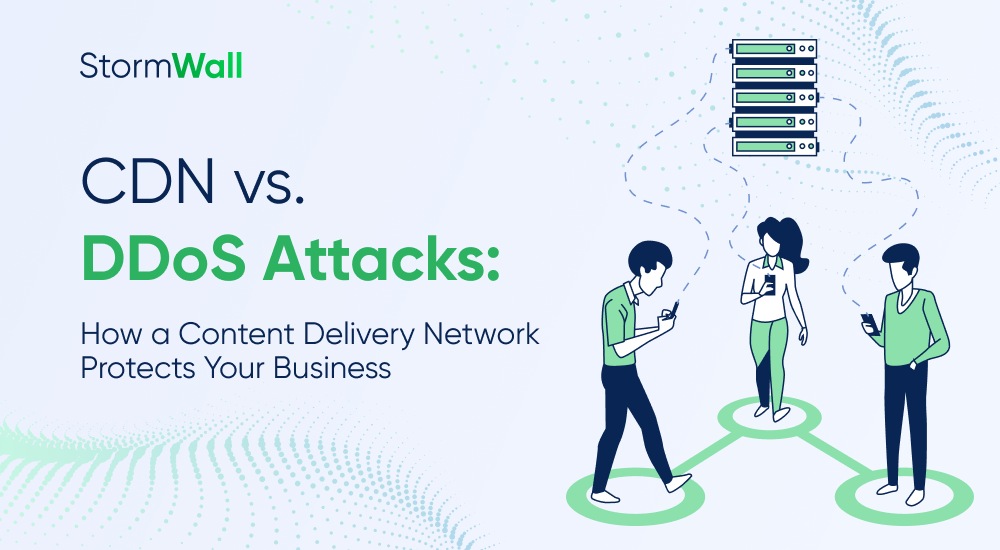In recent years, the number of DDoS attacks worldwide has been growing at record-breaking rates—an alarming trend highlighted in our analysts’ reports. Both large enterprises and small to medium-sized businesses are at risk.
Any web resource can become a target. One reason is the rapid evolution of botnets. Another is the low barrier to entry into cybercrime. Launching a DDoS attack today can be as simple as paying for access to a service on the dark web—something even a child could do. However, the consequences are far from trivial.
For most companies, DDoS resilience is a mission-critical concern. So, what role does CDN technology play in this context? Let’s take a closer look.

What Is a CDN?
A Content Delivery Network (CDN) is a service designed to deliver data to an unlimited number of users at maximum speed, regardless of where the content originates or is consumed.
How does it work? A CDN provider deploys multiple servers across different geographic locations. This distributed infrastructure allows the provider to cache and deliver web content—such as videos, images, and scripts—from the server closest to the user. As a result, the load on the origin server remains minimal, and content loads significantly faster for the end user.
How CDN Helps Protect Against DDoS Attacks
A DDoS (Distributed Denial of Service) attack seeks to disable a website by overwhelming its server with traffic. Typically, this malicious traffic originates from thousands of infected devices forming a botnet.
So how does a CDN reduce the risk and improve a site’s resilience?
First and foremost, a CDN decentralizes the handling of incoming traffic. Instead of a single server being hit with the entire load, traffic is distributed across multiple edge servers. This network-based load balancing significantly reduces the chances of the origin server becoming overwhelmed or crashing during a DDoS attack.
Another advantage is that many CDN services come with built-in traffic filtering capabilities. These include behavioral traffic analysis and IP address blacklisting—tools that help detect and block malicious activity before it reaches the origin server.
Content caching also plays a critical role. With a CDN, users receive pre-cached versions of web pages, which means fewer requests are sent to the origin server. This alleviates backend load and diminishes the impact of volumetric DDoS attacks.
Finally, CDNs are architected to handle high traffic volumes by design. Equipped with redundancy and spare capacity, they remain fault-tolerant even amid sudden traffic surges.
Another important point—many CDN services, including their basic plans, provide minimal built-in DDoS protection functionality. In some cases, CDNs operate at both the L3/L4 (network and transport) layers and the application layer (L7), partially incorporating features such as Web Application Firewall (WAF) capabilities and behavioral traffic analysis.
CDN Alone Isn’t Enough
The limitations of this protection method are primarily tied to architectural nuances. If the origin server’s IP address is exposed, attackers can bypass the CDN and direct the attack straight to the source. In such cases, the CDN offers limited protection compared to a purpose-built anti-DDoS solution or a Web Application Firewall (WAF).
Additionally, effective DDoS mitigation via CDN requires proper configuration. This includes setting up DNS records correctly, applying filtering rules, defining caching policies, and planning traffic handling logic. Not every IT specialist has the expertise to set this up optimally.
Another issue is that key DDoS protection features offered by CDN providers—such as custom configurations, SLA-backed performance guarantees, and priority technical support—are often not available to all users. These features may be missing entirely or restricted to premium pricing tiers.
And most importantly, if your web application has a non-standard configuration, integration challenges are likely. You may need to manually configure everything from routing rules to logic for handling specific request types—adding complexity and effort beyond what many CDN solutions are designed to support.
So, What’s the Bottom Line?
On one hand, a CDN is a powerful technology that can be used not only to accelerate content delivery but also to provide basic protection for web resources. By leveraging CDN services, organizations can reduce the risk of financial losses and other consequences of DDoS attacks. This is especially relevant for small and medium-sized businesses that may not yet have the budget or time for a dedicated security solution.
On the other hand, relying solely on a CDN is insufficient if you require maximum security assurance and rapid response to complex or non-standard attacks. In such cases, deploying a specialized anti-DDoS solution is advisable. Fortunately, many providers—like StormWall—offer DDoS protection and CDN service as part of an integrated package.

DDoS Protection for Websites
- Activate protection in 10 minutes
- 24/7 technical support




















